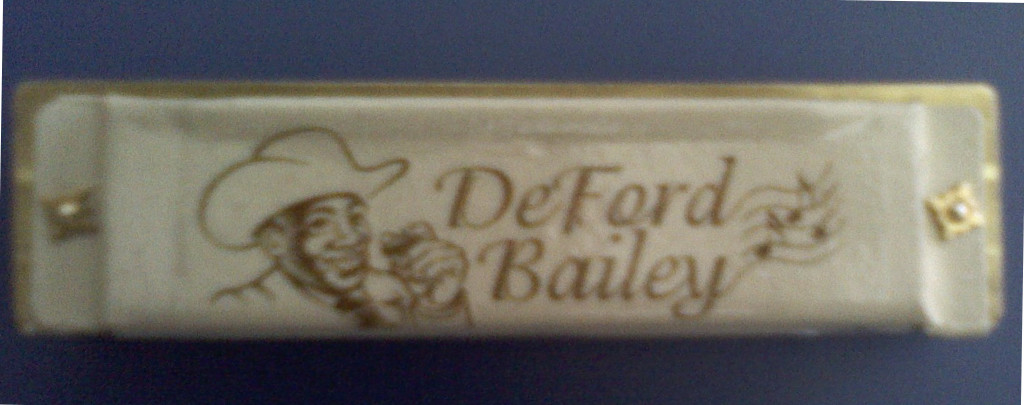The Trademark Trial and Appeal Board is a tribunal of limited jurisdiction. All it has to decide is whether a particular applicant or registrant may own a registration for a particular trademark. In other words, it doesn’t have to decide who wins as between two parties, but rather just has to decide whether one party can satisfy the conditions for registration. And sometimes I think they must be grateful for their limited jurisdiction because it makes their job a little easier.
DeFord Bailey LLC v. Bailey is that kind of case. If you couldn’t guess from the caption, it’s a family matter. DeFord Bailey, Sr. was, according to the opinion, a “harmonica virtuoso inducted into the Country Music Hall of Fame and remembered as the first African American performer on the Grand Ole Opry.” He died intestate and unmarried in 1982 so his three children were his sole heirs. One of them, DeFord Bailey, Jr., was the progenitor of the three parties involved in the lawsuit. DeFord Jr. formed the opposer, DeFord Bailey LLC, with one of his granddaughters and assigned all intellectual property rights he had in the name “DeFord Bailey” to the LLC. He died is 2013 and his granddaughter became the sole owner of the LLC.
On April 26, 2011 two of DeFord Jr.’s sons, Carlos DeFord Bailey and DeFord Bailey III, applied to register the trademark DEFORD BAILEY for harmonicas under Section 1(a) of the Lanham Act, claiming a date of first use April 11, 2011.
In 2012, Carlos signed a “Name and Likeness Licensing Agreement” with the LLC allowing him to sell harmonicas and T-shirts. Carlos testified that he sold harmonicas for the first time at a “rose garden ceremony” after he signed the agreement, although had given them away before that. The agreement provided that:

If you can’t see the image, it says in part:
Except for the license granted hereunder and as otherwise provided herein, … [Carlos Bailey] acknowledges and agrees that it will not have any right, title or interest in or to the Licensed Property, and [Carlos Bailey] shall not make any claim of ownership or interest in or to such Licensed Property.
Which was the end of the matter for Carlos Bailey; the Board held that “We therefore deem it appropriate to hold him bound by his clear contractual representation that he claims no right, title or interest in the applied-for mark. Therefore, he cannot properly claim ownership of the applied-for mark.”
As to DeFord III’s interest,
His representations about the Application and the applied-for mark remain contradictory and muddled. The record includes documents signed by him stating that he was unaware of the Application at issue and had not authorized its filing. He then gave conflicting testimony about whether he signed those documents. After initial repeated denials, he ultimately admitted that he did sign them but claimed that he may have done so only because of a request by his father. As to the Application itself, the file record shows that it was filed electronically, and contained electronic signatures using the method of names appearing in between forward slashes. The signatures on the Application by Mr. Benjamin [the applicants’ attorney], Carlos Bailey, and DeFord Bailey, III are required to have been “[p]ersonally enter[ed]” in accordance with Trademark Rule 2.193(c)(1). 37 C.F.R. § 2.193(c)(1). DeFord Bailey, III offered testimony casting doubt as to whether he actually signed the Application, whether he authorized its filing in advance, and if so, whether he knew and understood what he was signing. He testified that he never met the attorney who filed the trademark application until the testimony deposition and stated twice that his first phone conversation with the attorney took place after the Application was filed. DeFord Bailey, III responded to a question about how he authorized Mr. Benjamin to file the Application by stating “By being DeFord Bailey and I had signed off – somebody said I signed off, which I didn’t realize I had signed off on.” Overall, we find that DeFord Bailey, III’s testimony regarding the Application and the applied-for mark lacks reliability, reflects that he made no use of the applied-for mark in connection with the use-based Application or otherwise, shows that he relies only on the use by Carlos to support rights in the applied-for mark, and ultimately fails to support his joint ownership of the applied-for mark. Based on his testimony, coupled with the documentary evidence in which, after the filing of the Application, he disavowed any knowledge of it or involvement in it, we conclude that DeFord Bailey, III cannot properly claim ownership of the applied-for mark.
So Carlos and DeFord III were not owners of the use-based application for DEFORD BAILEY for harmonicas.
But what do we NOT know about this situation?
- What rights DeFord, Sr. started with – did he have any trademark rights? There’s no mention of a trademark use by the LLC. The LLC’s opposition was based on Section 2(a), false endorsement, and 2(d), likelihood of confusion. The false endorsement might be viable but not likelihood of confusion if the LLC didn’t use LEFORD BAILEY as a trademark.
- Whether DeFord Jr., and therefore the LLC, was the only owner of whatever rights there were – DeFord, Jr. was one of three heirs and there’s no mention of what interest the other two might still have.
- The subject application was filed and Carlos and DeFord, III formed their own corporation about a month before the LLC was formed. Had DeFord, Jr. meant for his sons to have the rights?
DeFord Bailey LLC v. Bailey, Opp. No. 91209857 (TTAB Jan. 14, 2016)

The text of this work is licensed under a Creative Commons Attribution-No Derivative Works 3.0 United States License.


Leave a Reply